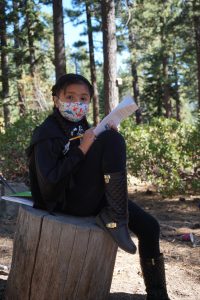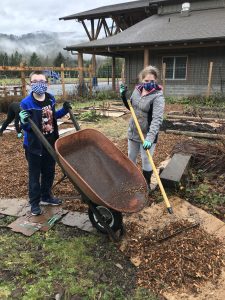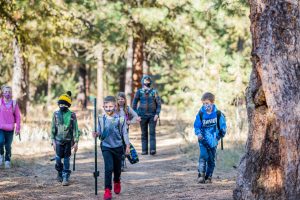Outdoor In-Person Learning: Partnerships in the Pandemic Spotlight Series
By Cristina Edwards and Emilie Lygren
Over the course of the past year, the BEETLES team has heard many stories about how the environmental education community is adapting to the Covid pandemic. From Zoom classrooms to widely spaced outdoor stump circles, this community has shined with its creativity and flexibility in continuing to teach––both in-person and virtually––despite many layers of added difficulty.
 As experts have come to better understand transmission of the SARS-CoV-2 virus, we’ve increasingly been encouraged by health officials to spend time with others outdoors in the open air, including during school.
As experts have come to better understand transmission of the SARS-CoV-2 virus, we’ve increasingly been encouraged by health officials to spend time with others outdoors in the open air, including during school.
With pandemic physical distance requirements, the outdoor classroom offers an appealing space to do the work we love, safely. While 2020 was a difficult year for educators, we heard many innovative stories of outdoor science and environmental education leaders and instructors partnering with school districts to offer in-person learning experiences for students. We’ve also heard exciting stories of organization leaders in outdoor science and environmental education using the pandemic as an opportunity to generate interest in and support for more outdoor learning within their school districts and partner communities.
We’re excited to introduce a series of interviews spotlighting a few of the ways outdoor educators have partnered with schools to provide environmental education and outdoor learning experiences. There is a great variety in how outdoor learning programs are operating. They’re happening on-site at schools, and offsite at outdoor education organizations. They’re using a variety of equipment, from hula hoops to hotspots. They’re happening on different schedules, from as frequent as every day to once a week. They serve a range of subgroups of students, from students who aren’t logging in to virtual learning, to children of school district employees.
 This series will highlight a range of partnerships and approaches. We hope that reading these interviews inspires you and encourages you to think about ways you might incorporate some of these ideas into your plan for outdoor education in 2021. We also hope these interviews offer some valuable perspectives and ideas for organizations hoping to partner with schools and districts to facilitate outdoor learning in these unprecedented and challenging times.
This series will highlight a range of partnerships and approaches. We hope that reading these interviews inspires you and encourages you to think about ways you might incorporate some of these ideas into your plan for outdoor education in 2021. We also hope these interviews offer some valuable perspectives and ideas for organizations hoping to partner with schools and districts to facilitate outdoor learning in these unprecedented and challenging times.
Here are a few common themes and interesting points that emerged in our conversations with organization leaders coordinating outdoor learning partnerships with school districts all over the country:
- Schools want outdoor learning – but setting up an outdoor learning program requires a strong advocate. We resoundingly heard that communities, districts, and families were interested in outdoor learning for their kids. We also heard that it takes a lot of effort to translate this desire into reality. Schools are already swamped with adapting to virtual learning, so successful outdoor learning programs need a strong advocate. This person can be from an outside organization, the community, or the district. Learn about how Sierra Nevada Journeys advocated for their program.
- There are many dimensions of equity and access to consider. In considering how to make outdoor learning impactful in our communities, we have a variety of challenges to think about. Internet access, transportation, and funding all play a role in making outdoor learning equitable. Read about how Santa Cruz Outdoor Science School navigated this.
- Previous partnerships can be a great place to start. Many of the people we spoke with built on relationships that existed pre-pandemic. It’s a lot easier than starting from scratch. Learn about how Wolf Ridge Environmental Learning Center leveraged existing relationships.
- Kids missed spending time with other kids in person. Outdoor learning has filled a deep longing: kids just want to play with other kids! The social and emotional benefits of outdoor learning have been multiplied during the pandemic, when we have fewer in-person social interactions than before. Read about the social-emotional benefits McCall Outdoor Science School observed at their in-person program.
- There are kid-specific safety considerations. There are unique challenges in asking kids to stay physically distanced, but kids understand some requirements, like masking and hand sanitizing, maybe even better than we thought they would. It varies a lot depending on age level though – some kindergarteners just want to hold your hand. Learn how North Cascades Institute navigated physical distancing requirements with kids.
- It’s a great time for reimagining. The professionals we interviewed were all doing their best with what they had. Every school and community is unique and has different capacities and resources. The solutions that you end up with might not be the solutions you imagined at the beginning, but learning outdoors can happen in many different set-ups. Read some of the solutions Portland Public Schools developed during the pandemic.
 The professionals we interviewed represent just a sample of the many efforts across the country to keep kids connected and learning during the Covid pandemic. We are excited to continue to connect with and learn about the many ways outdoor education organizations are offering high-quality, meaningful learning experiences for youth. The pandemic has created changes that will last long after the virus is contained. Virtual learning, outdoor classrooms, and ongoing partnerships will continue after the pandemic ends, and we’ll emerge with new skills in our toolkits.
The professionals we interviewed represent just a sample of the many efforts across the country to keep kids connected and learning during the Covid pandemic. We are excited to continue to connect with and learn about the many ways outdoor education organizations are offering high-quality, meaningful learning experiences for youth. The pandemic has created changes that will last long after the virus is contained. Virtual learning, outdoor classrooms, and ongoing partnerships will continue after the pandemic ends, and we’ll emerge with new skills in our toolkits.
In this series (click each name to read the interviews):
- Brooke Teller is the District STEM Coordinator for Portland Public Schools in Portland, Maine. We spoke with Brooke about the ways her district has pivoted toward outdoor learning during the pandemic. These partnerships emerged from existing relationships, and a strong desire from school administrators and families to be able to provide outdoor learning opportunities for their students.
- Sean Hill is the Vice President of Education at Sierra Nevada Journeys in Reno, Nevada. He shared advice on getting the attention of school districts when there wasn’t an established partnership already.
- Heather MacDougall Molloy is the Director of Outdoor Science School for the Santa Cruz County Office of Education. She shared insight on how communication with parents around expectations allowed for responsiveness to her instructor’s needs.
- Jeff Giesen is the Associate Director at the North Cascades Institute in Rockport, Washington. Jeff shared how his organization created a pandemic outdoor learning program to address existing needs beyond just outdoor education.
- Karla Eitel and Beth Kochevar are the Executive Director and K-12 Residential and Outreach Programs Coordinator, respectively, at McCall Outdoor Science School in McCall, Idaho. Karla and Beth describe how their existing partnerships with their K-12 school district led to the creation of an in-person outdoor learning program. They also share their safety practices and protocols, and offer perspectives on their experience inviting a local public health specialist to visit and evaluate the program.
- Joe Walewski is the Director of Naturalist Training at Wolf Ridge Environmental Learning Center in Finland, Minnesota. We spoke with Joe about how existing relationships with local charter schools grew into something larger during the pandemic.

Have you heard about someone doing great outdoor, in-person learning? We want to hear from you! Email us at beetles@berkeley.edu.

Leave a Response